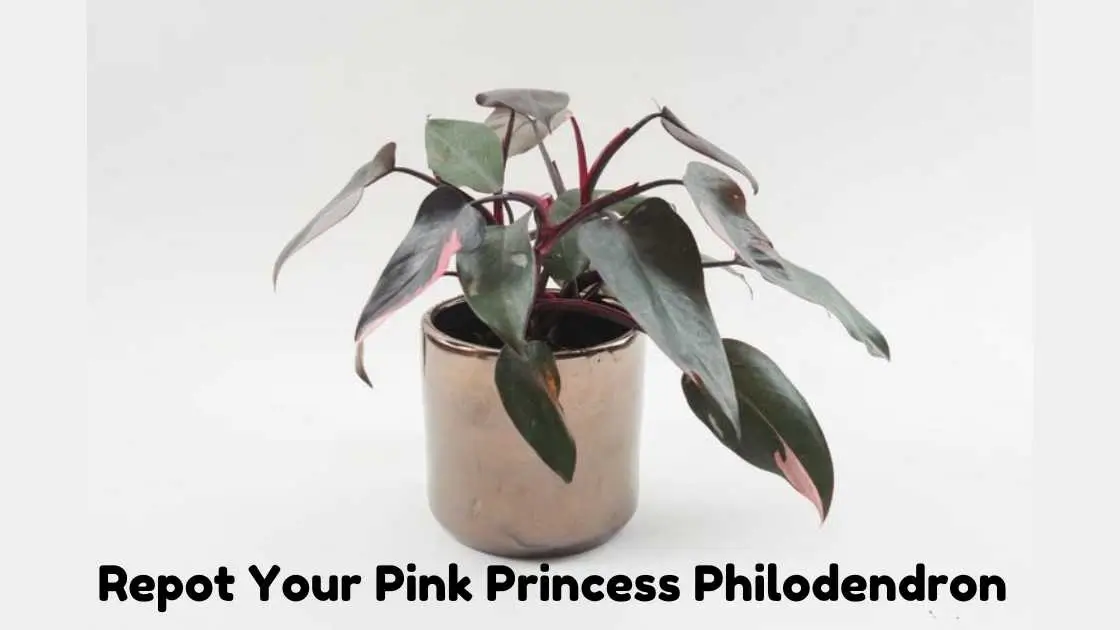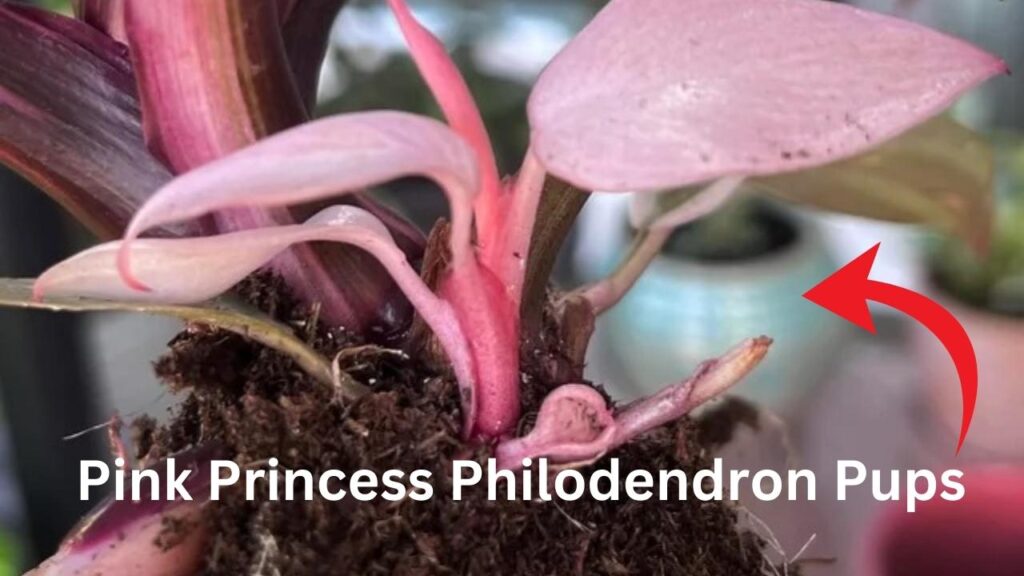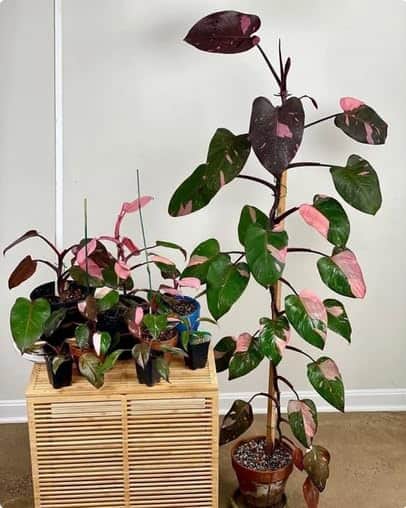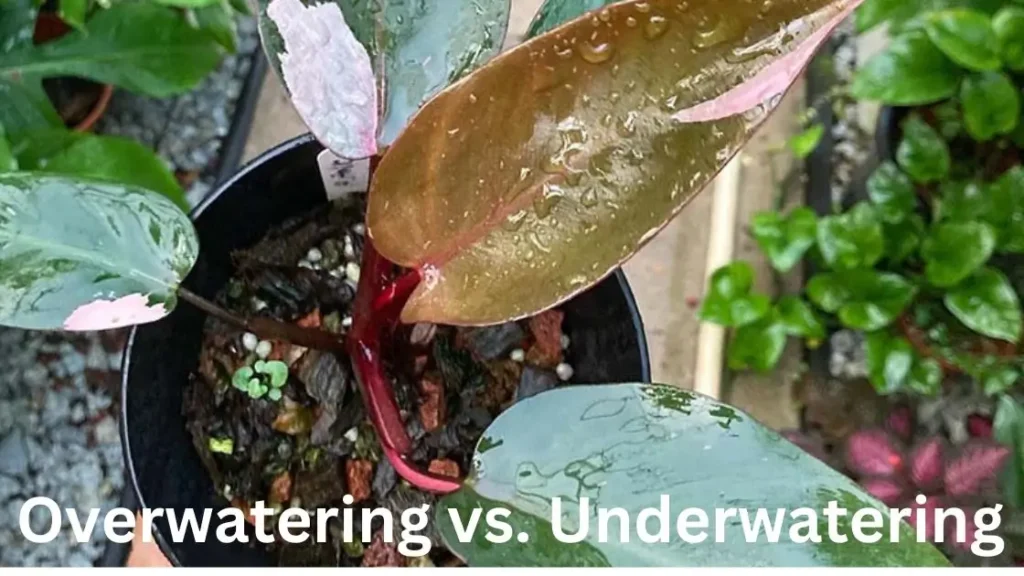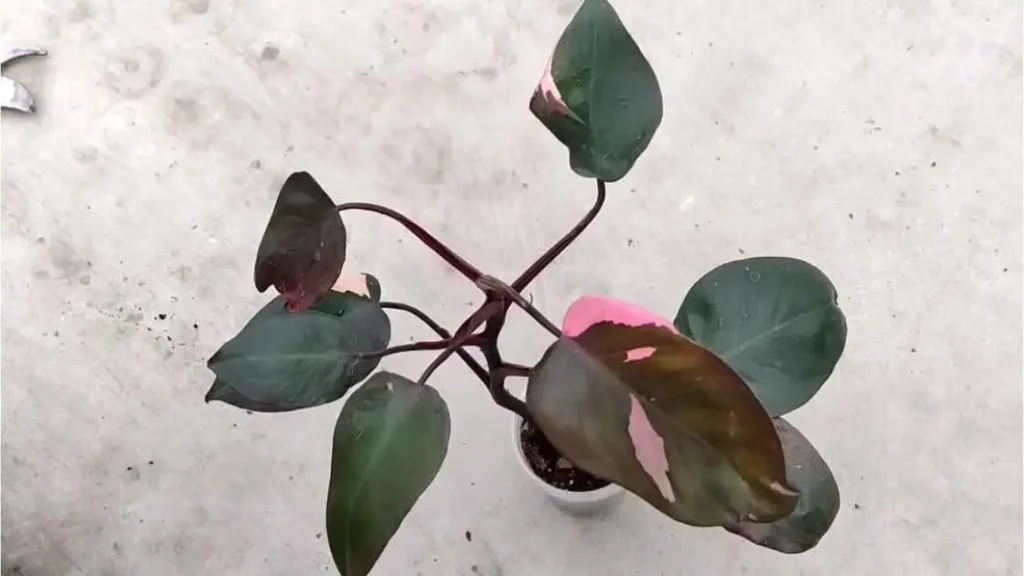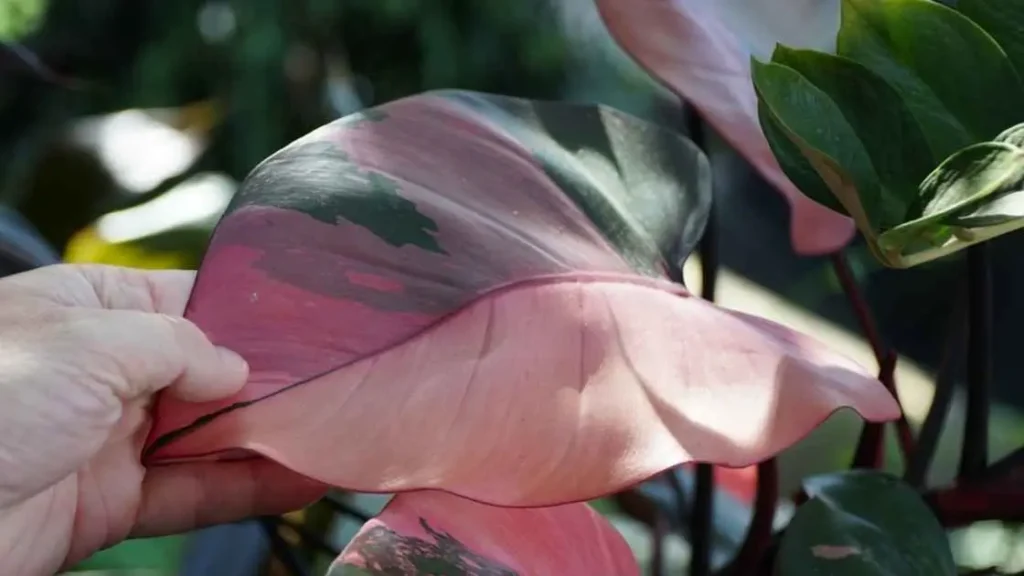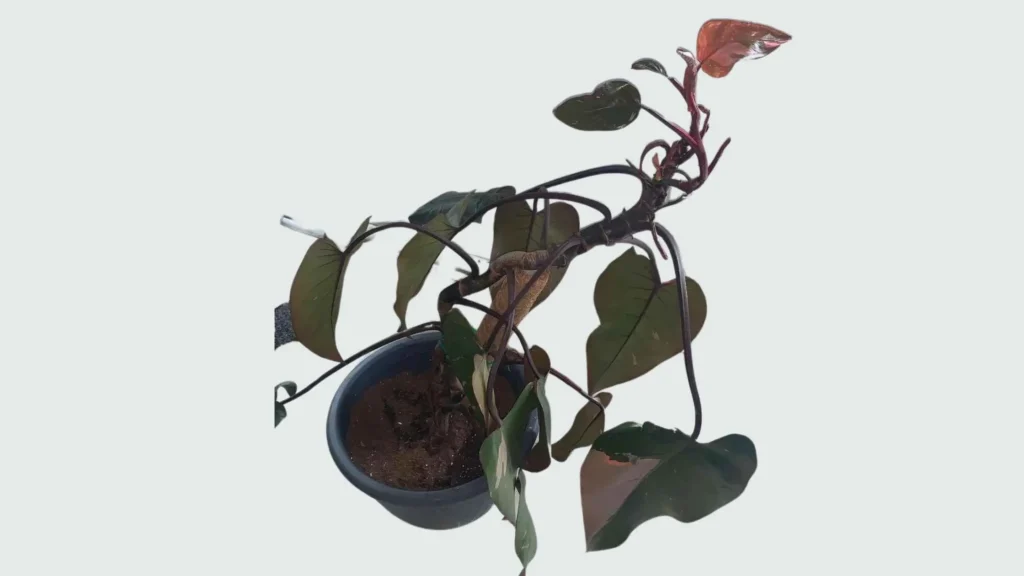Table of Contents
ToggleI know, repotting can feel scary. You might worry about hurting your plant or not knowing when the time is right. Don’t worry, I’ve been there too! But once you know the signs and have a clear guide, it’s much easier. In fact, it can even be a fun way to help your plant grow.
In this guide, I’ll show you everything you need to know about repotting your Pink Princess Philodendron. We’ll talk about when to repot, what soil to use, how to pick the right pot, and how to care for your plant after. So, grab your gloves, and let’s get started!
Why Repotting Your Pink Princess Philodendron is Important?
If you’re like me, you want your plants to do well, not just survive. For the Pink Princess Philodendron, taking good care of it is key. A big part of that care is repotting. But why is repotting so important?
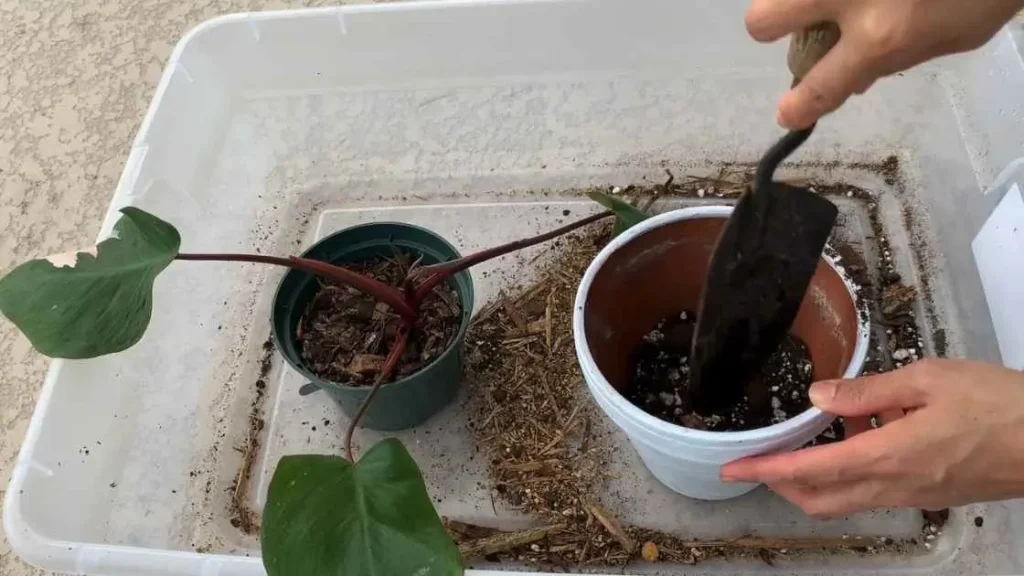
First, repotting gives your plant more room to grow. If you see roots coming out of the drainage holes or curling around the edges, it means your plant is running out of space. A plant with crowded roots can’t grow well because it needs room to spread out. The Pink Princess grows fast when happy, so repotting helps it keep growing those beautiful pink and green leaves.
Another reason to repot is to give the plant fresh soil. Over time, the soil loses nutrients, and your plant needs more food to grow. Also, old soil can become tight and stop air from getting to the roots. Repotting gives your plant new, loose soil that lets air in and keeps the roots healthy. Good soil is just as important as water—I learned that the hard way!
Finally, repotting helps stop root rot. Pink Princess plants don’t like too much water, and old soil can hold water for too long. Fresh, well-draining soil keeps your plant from sitting in water, which helps prevent root rot. If you find any mushy roots while repotting, you can cut them off, giving your plant a fresh start.
Repotting might seem like a big task, but it’s just part of helping your Pink Princess grow. Think of it like giving your plant a little spa day!
Signs That It’s Time to Repot
One of the hardest parts of plant care, especially with a rare beauty like the Pink Princess Philodendron, is knowing when to repot it. If you repot too soon, you might stress the plant. If you wait too long, you could slow its growth or hurt the roots. So, how can you tell when it’s the right time to repot your Pink Princess?
1. Roots Coming Out of Drainage Holes
This is one of the biggest warning signs. If you see roots coming out of the drainage holes, it means your plant needs more space. The roots are trying to find more room because the plant has outgrown its pot.
2. Soil Dries Out Too Quickly
Does your Pink Princess seem thirsty all the time? If the soil is drying out faster than normal, it could mean the roots have filled up the pot. When the plant is root-bound, the soil can’t hold water well, so you have to water more often. This is a sign that the roots need more space, and it’s time to repot.
3. Stunted Growth or Yellowing Leaves
Has your plant stopped growing new leaves? Or are the leaves getting smaller? This could mean your Pink Princess is root-bound. When roots don’t have enough room, the plant can’t take in enough water and nutrients. This leads to slow growth or even yellow leaves.
4. Circling Roots at the Surface
If you lift your plant from its pot and see roots tightly circling the root ball or edges, it’s time to move your Pink Princess to a bigger pot. Circling roots mean the plant has outgrown its current home.
5. Soil Condition is Poor
If the soil looks hard, clumpy, or doesn’t drain well, it’s time for new soil. Over time, even good soil can break down and get dense. This stops water and air from moving through. Repotting with fresh soil helps your plant grow better.
Knowing these signs makes repotting easy. If you see any of them, it’s time to give your Pink Princess a new pot and soil so it can keep growing strong!
Best Time to Repot Your Pink Princess Philodendron
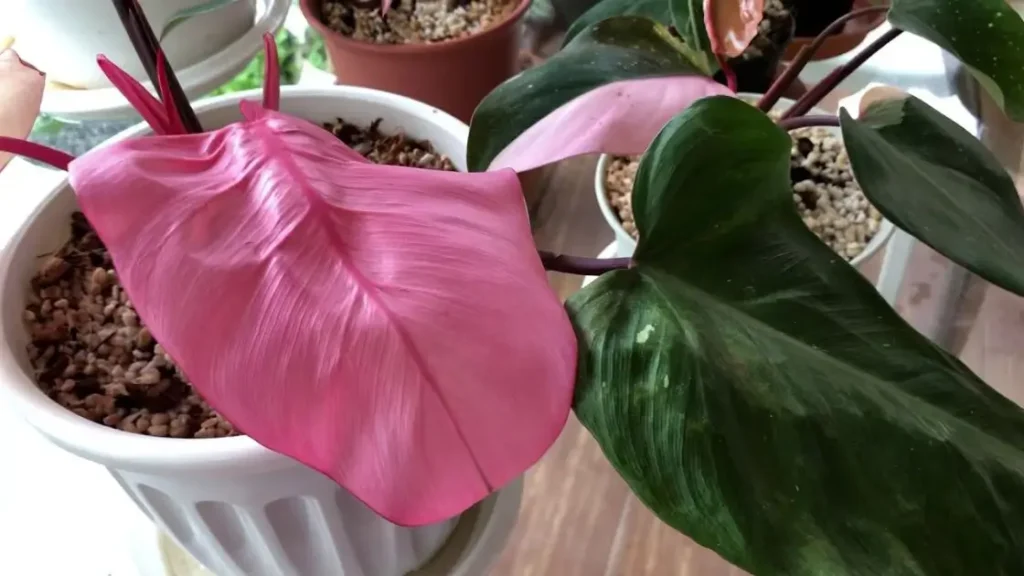
Timing is important when repotting your Pink Princess. You can repot any time of year, but some seasons are better. They help reduce stress and support growth.
Spring and Summer: The Growing Season
Spring and early summer are the best times to repot your Pink Princess Philodendron. During these warmer months, the plant grows new roots and leaves. Repotting now helps it recover quickly. The warmer weather and more sunlight give it energy to settle into its new pot.
When I repotted my Pink Princess last spring, it grew back fast. In just a week, I saw new leaves! Repotting during the growing season makes the plant stronger and helps it adapt to changes more easily.
Avoid Repotting in Fall or Winter
Fall and winter are not the best times to repot your Pink Princess. The plant slows down during these months and does not grow much. Repotting then can be risky because the plant can’t handle stress as well. It will take longer to recover.
However, there are exceptions. If your plant is root-bound or shows problems like yellow leaves or slow growth, you might need to repot it, even in cold months. Be ready for a slower recovery, and watch the plant closely. Make sure it gets the right amount of light and water while adjusting.
When Should You Not Repot?
Avoid repotting right after watering. Wet soil is heavy and sticks to the roots, making it hard to take the plant out. Instead, wait until the soil is dry or almost dry before repotting.
In short, if you want your Pink Princess to thrive, repot it in spring or early summer. This is when your plant is strong, and it will adjust better to its new pot.
Materials You’ll Need
Repotting your Pink Princess Philodendron is easy and doesn’t need many tools. A few basic items will help make the process smoother. I like to set everything up before I start. It makes the job less messy and stressful.
Here’s what you’ll need:
1. New Pot (1-2 Inches Larger)
When picking a new pot, choose one that is 1-2 inches wider than your current pot. A pot that is too big can hold too much water, which can hurt your plant by causing root rot. The goal is to give your plant space to grow without making it too hard for it.
Make sure the new pot has holes for draining water. Drainage is very important for the Pink Princess. Without it, water will stay at the bottom, which can cause root rot. Terracotta pots are a good choice because they let air flow better. Plastic pots are also fine.
2. Well-Draining Potting Mix
Not all soil works for your Pink Princess Philodendron. You need soil that is light, airy, and drains well. I suggest using a mix of potting soil, perlite, and orchid bark. This mix helps with drainage and gives the roots something to grow on.
I like to use one part potting soil, one part perlite, and one part orchid bark. You can also add a little charcoal to control moisture. This mix is like the natural soil where the Pink Princess grows best.
3. Gloves
Gloves might seem like a small thing, but they help a lot. Repotting plants can get messy. Wearing gloves keeps your hands clean. Gloves also protect your skin from getting irritated by the soil. I find that gloves make it easier to handle plants. They help you work without worrying about damaging the roots.
4. Trowel or Small Spade
A trowel or small spade helps you move the plant from its old pot to the new one. It also loosens the hard soil around the old pot’s edges. You can use it to scoop fresh soil into the new pot without making a mess.
5. Pruning Shears (Optional)
Pruning shears are not always needed, but they can be helpful. If you see any dead or damaged roots while repotting, you can trim them. Cutting off bad roots gives your plant a fresh start and helps stop disease from spreading. Be sure to clean your shears before using them to keep the plant safe from bacteria.
6. Watering Can
After repotting, water your plant well to help it settle. A watering can with a narrow spout helps you control the flow, so you don’t overwater. Give the plant a good soak at first, but make sure extra water drains out.
Step-by-Step Guide to Repotting Your Pink Princess Philodendron
Now that you have your materials ready, it’s time to start repotting. If this is your first time, don’t worry—I’ll guide you step by step. With a little care, your Pink Princess will be in its new home soon!
1. Water Your Plant the Day Before
Water your Pink Princess a day or two before repotting. This keeps the roots hydrated and flexible, making it easier to move the plant. Moist soil is also easier to work with, and it reduces the chance of stress or damage.
2. Remove the Plant from Its Current Pot
Gently tip the plant out of its pot by holding the base. If it’s stuck, don’t worry—use a trowel or your fingers to loosen the soil. If it’s in a plastic pot, gently squeeze the sides to help the plant come out.
3. Inspect and Clean the Roots
Once your Pink Princess is out of the pot, check the roots closely. If you see any that are brown, soft, or smell bad, they are likely rotting and should be cut with clean pruning shears. Healthy roots are white or light tan and feel firm. If the plant’s roots are tightly wrapped, gently untangle or trim them to help it grow in the new pot.
4. Prepare the New Pot
Add a layer of fresh soil to the bottom of the new pot. Make sure the pot has drainage holes. This will stop water from building up at the bottom and prevent root rot. The soil at the bottom helps the roots settle when you place the plant.
5. Place the Plant in the New Pot
Hold the Pink Princess upright and center it in the new pot. With one hand holding the plant, fill the sides with fresh soil. Keep the plant at the same level as before. Don’t bury the stem too deep, or it may rot.
6. Fill and Lightly Press the Soil
As you add new soil, press it down lightly to remove big air pockets. Don’t press too hard. The soil should stay loose so the roots can breathe and water can flow easily.
7. Water Thoroughly
Once the plant is in its new pot, water it well. Keep watering until you see water draining from the bottom. This helps the soil settle around the roots and removes air pockets. After this, let the top inch of soil dry before watering again to avoid overwatering.
8. Place the Plant Back in Its Spot
Finally, place your Pink Princess back in its usual bright, indirect light spot. It might feel some stress at first, but don’t worry—that’s normal. In a few days to a week, it should start showing new growth as it adjusts to its new home.
Aftercare Tips
Congrats! Your Pink Princess Philodendron is now settled in its new pot. But the work isn’t over yet. Aftercare is important to help your plant recover and keep growing. Let’s talk about the steps to take in the days and weeks after repotting.
1. Watering After Repotting
One of the most common mistakes after repotting is overwatering. I know it’s tempting to give your plant extra care, but too much water can hurt it. After the first deep watering, wait until the top inch of soil is dry before watering again. The roots need time to adjust to the new soil.
During the first few weeks, watch how fast the soil dries out. Since the plant has more room and fresh soil, the watering schedule may change a bit. Keep checking the soil and adjust your watering as needed.
2. Light Requirements
Your Pink Princess Philodendron loves bright, indirect light. Place it where it gets plenty of light, but avoid direct sunlight, which can burn the leaves. If it doesn’t get enough light, the pink color may fade, and the leaves will turn more green.
After repotting, the plant might feel some stress. Try to keep its environment stable. Putting it in the right light and keeping things consistent will help reduce stress and encourage faster recovery.
3. Humidity Levels
The Pink Princess is a tropical plant. It needs high humidity to grow well. If your home is dry, especially in winter, you should increase the moisture around the plant. You can mist the leaves, put the plant on a tray of wet pebbles, or use a humidifier. Keep the humidity between 50-60% to help the pink color stay bright.
4. Avoid Fertilizing Right Away
Wait 4 to 6 weeks before adding fertilizer after repotting. The new soil already has enough nutrients to help the plant recover. Adding more too soon can hurt the roots or burn them. After this time, you can use a balanced liquid fertilizer every 4 to 6 weeks while the plant is growing.
5. Monitor for Signs of Stress
It is normal for your plant to look stressed after repotting. You may see drooping, wilting, or yellow leaves. Don’t worry! The plant is just getting used to its new home. Watch it closely. If you have given it the right amount of water and light, it should get better in a week or two.
6. Watch for Pests
When you move a plant or its soil, pests might sneak in. After repotting, watch for pests like spider mites, mealybugs, or aphids. If you see any, act quickly. Clean the leaves with insecticidal soap or neem oil. A healthy plant is less likely to get pests, so take good care of it to keep infestations away.
Conclusion
Repotting your Pink Princess Philodendron is easy and helpful. It gives your plant a fresh start to grow better. Look for signs like roots coming out of the drainage holes or slow growth to know when to repot. A fresh pot helps your plant get vibrant pink and green leaves and strong growth.
Before repotting, be ready. Get the right pot size, well-draining soil, and all your tools. After repotting, remember to care for your plant. Water it correctly, keep it in bright, indirect light, and don’t fertilize too soon.
Repotting is a chance to bond with your plant, whether it’s your first time or not. Watching your Pink Princess grow in its new pot is very rewarding. It’s satisfying to see your plant thrive with the space and care you provide.
So, get your hands dirty and give your Pink Princess the care it needs. Your plant will thank you with its beautiful leaves.
FAQs
How often should I repot my Pink Princess Philodendron?
Repot your Pink Princess every 1-2 years. If you see roots coming out of the drainage holes or the soil dries out too quickly, it’s time to repot.
What kind of soil should I use for repotting?
Use a well-draining soil mix for your Pink Princess. A mix of potting soil, perlite, and orchid bark works well. This keeps the soil light and prevents root rot.
Can I repot my Pink Princess in the winter?
You can repot in winter if needed, like if the plant is root-bound or the soil is poor. But your plant will recover more slowly because it’s not growing much in the cold. It’s better to wait until spring if you can.
What size pot should I use?
Choose a pot that is 1-2 inches larger in diameter than the current one. Avoid choosing a pot that’s too large, as it can lead to overwatering and root rot.
How do I know if my Pink Princess is stressed after repotting?
It’s normal for your plant to show stress after repotting. Look for wilting, yellowing, or drooping leaves. As long as you give it the right light, water, and humidity, it should recover in a week or two.
Should I fertilize my plant right after repotting?
Wait 4-6 weeks before fertilizing after repotting. The new soil has enough nutrients for now. Fertilizing too soon can harm the roots. Resume your regular fertilizing schedule after your plant adjusts.
How do I prevent root rot when repotting?
Use a well-draining soil mix and a pot with drainage holes. Water only when the top inch of soil is dry. Trim any brown or mushy roots during repotting to avoid further damage.
Can I propagate my Pink Princess while repotting?
Yes, you can propagate while repotting. Take stem cuttings and root them in water or soil. Make sure each cutting has a few nodes and keep it warm and humid to encourage growth.
Related
Discover more from Pink Philodendron
Subscribe to get the latest posts sent to your email.

